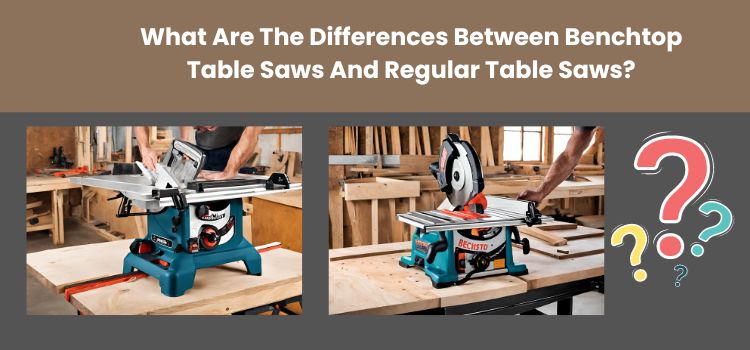What Are The Differences Between Benchtop Table Saws And Regular Table Saws?

Table saws are an essential tool for any woodworker, whether you are a professional or a hobbyist. They are used to make precise cuts on wood, which is necessary for creating furniture, cabinetry, and other woodworking projects.
However, with so many different types of table saws available on the market, it can be challenging to choose the right one for your needs.
In this article, we will explore the differences between benchtop table saws and regular table saws, and help you decide which one is right for you.
Comparing the differences between benchtop and regular table saws:
When it comes to choosing a table saw, there are two main types to consider: benchtop and regular. While both types of saws are designed to make precise cuts on wood, there are some significant differences between them.
Size and portability:
One of the most significant differences between benchtop and regular table saws is their size and portability. Benchtop table saws are smaller and more portable than regular table saws. They are designed to be placed on a workbench or table, which means they don’t take up much floor space.
They are also lightweight and easy to move from one location to another. Regular table saws, on the other hand, are larger and heavier than benchtop table saws, which makes them less portable.
They are designed to be placed on a sturdy base or stand, which means they take up more floor space.
Power and performance:
Another significant difference between benchtop and regular table saws is their power and performance.
Regular table saws are more powerful than benchtop table saws, which means they can handle thicker and harder woods.
They typically have a motor that ranges from 3 to 5 horsepower, which is enough to cut through most types of wood. They also have larger blades, which means they can make deeper cuts.
Benchtop table saws are not as powerful as regular table saws, but they are still capable of making precise cuts on wood.
They typically have a motor that ranges from 1 to 2 horsepower, which is enough to cut through most types of wood. However, they may struggle with thicker or harder woods.
Price range:
The price range is another significant difference between benchtops and regular table saws. Benchtop table saws are more affordable than regular table saws. They typically range in price from $100 to $500, which makes them an excellent choice for hobbyists or DIY enthusiasts who are on a budget.
Regular table saws are more expensive than benchtop table saws. They typically range in price from $500 to $2,000, which makes them a significant investment for most woodworkers.
Choosing the right table saw for your needs:
If you are a hobbyist or DIY enthusiast who has limited space and a limited budget, a benchtop table saw may be the best choice for you. If you are a professional woodworker who needs a saw that can handle heavy-duty work, a regular table saw may be the best choice for you.
Factors to consider:
Budget:
The first factor to consider when choosing a table saw is your budget. Benchtop table saws are more affordable than regular table saws, which makes them an excellent choice for hobbyists or DIY enthusiasts who are on a budget. Regular table saws are more expensive than benchtop table saws, which makes them a significant investment for most woodworkers.
Size of your workspace:
The size of your workspace is another factor to consider when choosing a table saw. If you have limited space, a benchtop table saw may be the best choice for you. They are designed to be placed on a workbench or table, which means they don’t take up much floor space. Regular table saws, on the other hand, are larger and heavier than benchtop table saws, which makes them less portable. They are designed to be placed on a sturdy base or stand, which means they take up more floor space.
Type of work you will be doing:
The type of work you will be doing is another factor to consider when choosing a table saw. If you will be doing light-duty work, such as cutting small pieces of wood, a benchtop table saw may be the best choice for you. If you will be doing heavy-duty work, such as cutting large pieces of wood, a regular table saw may be the best choice for you.
Type of wood you will be cutting:
The type of wood you will be cutting is another factor to consider when choosing a table saw. If you will be cutting softwoods, such as pine or cedar, a benchtop table saw may be the best choice for you. If you will be cutting hardwoods, such as oak or maple, a regular table saw may be the best choice for you.
Your level of experience:
Your level of experience is another factor to consider when choosing a table saw. If you are a beginner, a benchtop table saw may be the best choice for you. They are easy to use and are designed for light-duty work. If you are an experienced woodworker, a regular table saw may be the best choice for you. They are more powerful and are designed for heavy-duty work.
Examples of recommended models:
Here are some examples of recommended models for each type of table saw:
- Benchtop table saws: DEWALT DW745, SKIL 3410-02, Bosch GTS1031
- Regular table saws: SawStop PCS31230-TGP236, Powermatic PM1000, Delta 36-L552
Safety precautions to take when using a table saw:
Regardless of which type of table saw you choose, it’s essential to take safety precautions when using it. Here are some tips to keep in mind:
- Always wear eye and ear protection
- Keep your hands and fingers away from the blade
- Use a push stick or push block to guide the wood through the blade
- Keep the blade guard in place
Conclusion:
In conclusion, choosing the right table saw for your needs depends on several factors, including your budget, the size of your workspace, the type of work you will be doing, the type of wood you will be cutting, and your level of experience.
Benchtop table saws are more affordable and portable than regular table saws, but they are not as powerful. Regular table saws are more expensive and less portable than benchtop table saws, but they are more powerful and can handle heavy-duty work.
Regardless of which type of table saw you choose, it’s essential to take safety precautions when using it.
